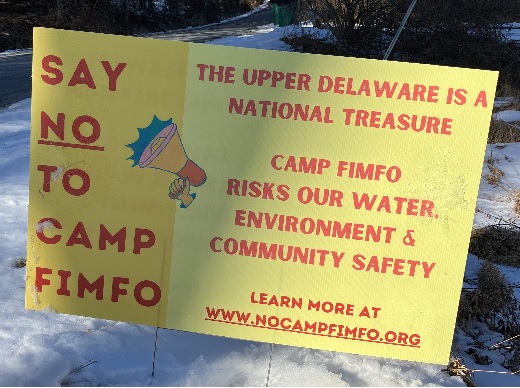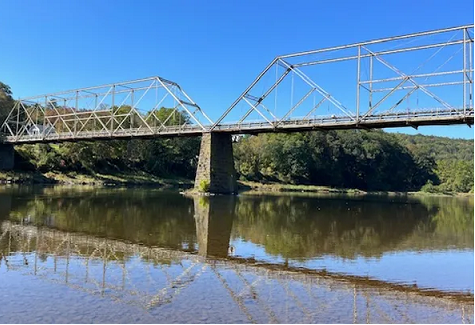
Support DCS Efforts to Save the Skinners Falls Bridge
February 2, 2025
NPS: FIMFO Will Have Adverse Impacts, Violates RMP
February 6, 2025Updated 3/4/25 with the FIMFO Zoom session held 3/1/25
Download the Zoom session slides as a pdf
Download the following as a pdf
TIPS ON WRITING A COMMENT LETTER ABOUT MY CONCERNS WITH FIMFO
I want to write a comment letter about my concerns about Camp FIMFO and its draft Environmental Impact Statement, but what do I say? I spent a little time looking it up, and prepared this cheat sheet.
Ultimately the lead agency (the Highlands Township Planning Board) is responsible for the adequacy and accuracy of the final Environmental Impact Statement (“EIS”). That is why comment letters from the public on FIMFO’s current draft Environmental Impact Statement (“DEIS” or “draft EIS”) are so important. We’re pointing out all the inadequacies and inaccuracies of that document. We’re also creating a record for a possible lawsuit.
*If you have already submitted a comment letter, you might want to review it to make sure that it addresses the adequacy and accuracy of the draft EIS. If it doesn’t, it’s possible that your comments won’t be taken into consideration, carry as much weight, or be addressed in the final EIS.
What I’ve gleaned is that at a minimum, a comment letter should specifically state (eg, in the “Re” line) that it concerns FIMFO’s submitted DEIS. The body of your letter should address where you think the DEIS is inadequate and/or inaccurate. It should cover one or more of the following topics:
- Does the DEIS adequately address the myriad issues and environmental impacts associated with the FIMFO project? (Think about the problems pointed out by the NPS, found here or the Delaware Riverkeeper, here.)
- Has it adequately taken into consideration the social, economic and other essential impacts of that project? (Think about the negative impacts pointed out in Jane Cypher’s letter, found here, or Louise Washer’s letter, found here.
- What important impact or essential consideration does the DEIS not address?
- Has there been an appropriate balancing of the benefits to harms?
Write whatever you think is wrong about the information disclosed in or missing from the DEIS. You don’t have to be a lawyer to say what you believe is true. Here’s the link to the DEIS documents.
*If you want to make sure you’ve dotted your i’s and crossed your t’s, or want to say more, submit another comment before the new deadline, and incorporate your first letter by reference.
Here’s a short summary of the legal process that the Planning Board appears to be following in evaluating the FIMFO EIS:
It’s following the regulations implemented by the NY Environmental Conservation Law (found at 6 CRR-NY 617.9, which establish a process under the State Environmental Quality Review Act (“SEQRA”) pursuant to which the environmental impacts (and social and economic impacts) of a project are evaluated. The Act can be found here.
The steps that have to be taken to satisfy SEQRA review, and that appear to be followed in the FIMFO application process, can be found here.
The pertinent SEQRA steps, given where we are in the FIMFO EIS approval process, are (in a nutshell) listed below. The steps that are still ahead of us are in bold print.
-Step 5 of that process requires a scope of the project to be published which identifies the issues to be addressed in the draft EIS. FIMFO did that here.
-Step 6 & 7 are the preparation of a draft EIS (DEIS) and consideration of the same by the planning board. FIMFO did that, it was accepted as adequate, and a notice of completion issued.
-Step 8 is publishing the Notice of Completion of the DEIS for review & public comment.
-Step 9 & 10 are the public comment period (extended to March 11, 2025) and the public hearing if one is deemed necessary (I think that’s already been held?).
-Step 11 covers the final EIS. “The final EIS must consist of: the draft EIS, including any necessary revisions and supplements; copies or a summary of the substantive comments received and their sources; and the lead agency’s response to the comments.”
-Step 12 is the final step, where the Planning Board does its own written SEQR findings statement. A positive findings statement means that FIMFO is approvable after consideration of the final EIS, and demonstrates that it “is the one that avoids or minimizes adverse environmental impacts presented in the EIS and weighs and balances them with the social, economic and other essential considerations. If the action is not approvable, a negative findings statement documenting the reasons for the denial must be prepared.”
At the end of the day, if FIMFO’s EIS is approved over the public’s objection, the only recourse would be to sue the deciding agency in NYS court.
Submit your written comment on the Camp FIMFO Draft Environmental Impact Statement (DEIS) by March 11, 2025 by email to planningboardzba@townofhighlandny.com. Please copy the DCS at DCS@DamascusCitizens.org!




